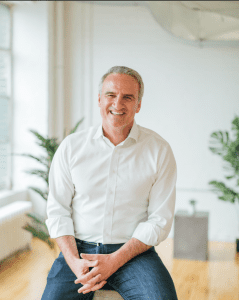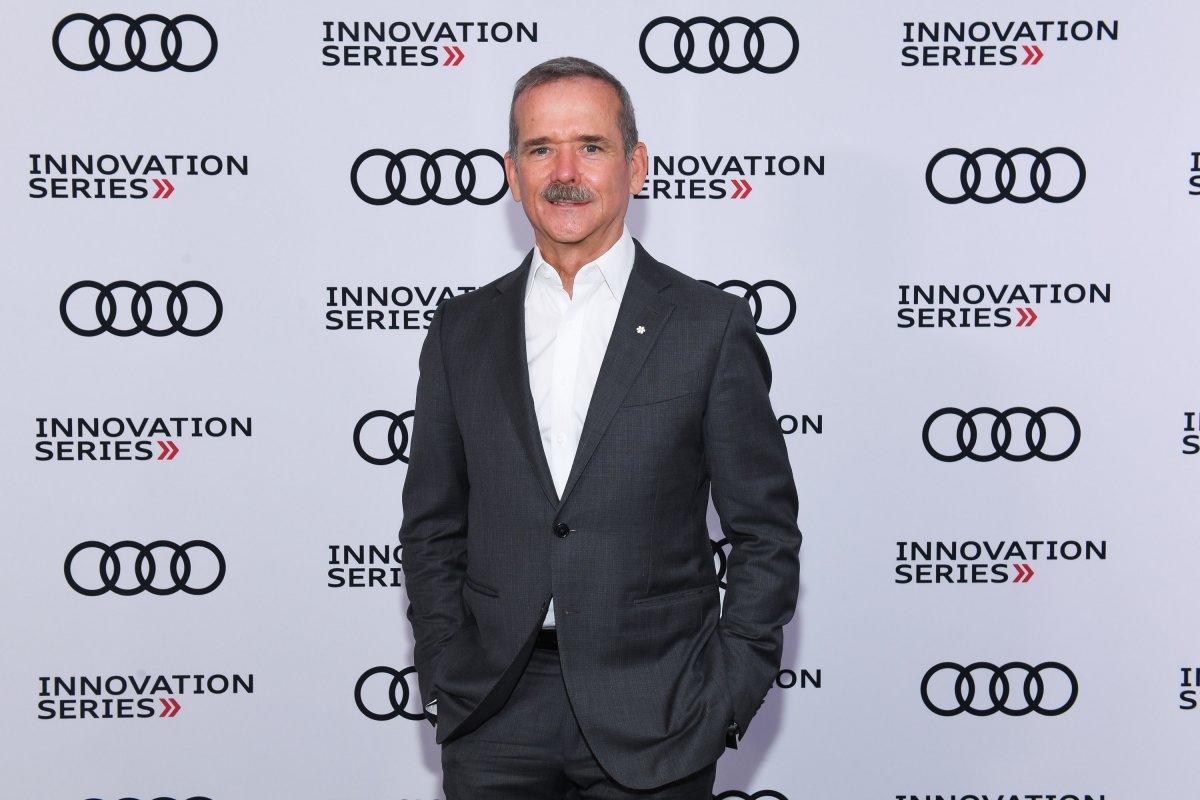[vc_row][vc_column][vc_column_text]Lane is using automation and innovation to take the workplace from cubicles and coffee stands to a full-functioning ecosystem.
In 2014, Kofi Gyekye and Clinton Robinson came up with the concept for a work experience platform. Following years of working in office spaces, they realized that the workplace was one of the last sectors to move forward into the digital age.
Enter Lane; the enterprise SaaS (Software as a Service) solution integrates building systems into a single, centralized, and user-friendly digital platform. Lane streamlines all aspects of day-to-day office life for tenants and property managers alike—from room bookings and guest registration to access control and communications to engaging with a building’s retailers and beyond—using data to drive insights every step of the way.
“One thing that we hear a lot from our customers, especially property managers, is about the ease that our different technology solutions provide,” said Gyekye. “They used to type an email out, send the email, then print the exact same notice to tape along office walls and in elevator systems. Now, they’re able to have a one-stop-shop and dashboard to share information and make decisions around.”
As for the user side, employees can experience their workplace in a whole new way; they can access communication from building management and learn about surrounding events all from the palm of their hand. Lane can help users book a meeting room, notify them of fitness classes or let them know about promotions within the building’s retail space.


Gyekye compares the ease of applications like Uber and its disruption of the transportation market, to what Lane hopes to do with commercial real estate. With their recent round of Series A funding, they’re on their way to doing so.
In June, Lane raised $10 million, led by Round13 Capital. The Lane team is looking forward to global expansion, doubling their 40-person team by the end of the year and deepening their focus on delivering a strong user experience to all members of the workplace.
Operating in 300 million sq. ft. of commercial real estate, Gyekye hopes Lane makes coming into work something that people look forward to, stimulating the workplace to come alive through connection and communication.
“We are a full platform. We live on all your elevator screens. We integrate all the lobby screens, and we’re your central source of communication automation,” he said. “We really communicate, we automate and we help companies adapt to the changing needs.”
Lane is a leader in the property technology industry and is disrupting the workplace in the best way possible. For this week’s Start-Up Spotlight, Bay Street Bull spoke with Kofi Gyekye, co-founder and CPO of Lane, about taking the workplace into the digital age and finding inspiration in everything.[/vc_column_text][vc_text_separator title=”Q&A” border_width=”3″][vc_column_text]You and Clinton have worked on other projects together before, did the idea for Lane come from past grievances in the workplace? What sparked the idea between the two of you?
We recognized inefficiencies in how we interacted with our work life: it wasn’t easy, it wasn’t efficient and it didn’t feel great. You didn’t go to work thinking, ‘Yes! This is going to be amazing.’
We were thinking about these ideas and formulating about how to impact the space, when we watched the movie Her. There’s this scene of Joaquin Phoenix where he’s in the elevator and he’s really sad. Essentially we were like, ‘Wait a minute. Let’s build an operating system, an AI that can connect a person, through technology, to their environment to get rid of that loneliness.
The workplace didn’t go through the same digital revolution as everybody else; it was left behind. We realized that if you could just improve someone’s work day through a good ecosystem, it could increase their happiness and productivity. So that was the play. We saw it then, and we still believe it’s an amazing opportunity, and we really want to change the way people interact with their work lives.
You guys were founded about half a decade ago, but with your recent Series A funding, you’re about to really take off. Why was now the right time to expand?
Lane was a part of the defining moment around workplace experience and property technology. I think landlords—specifically on the commercial real estate side—were dealing with a new customer base. Millennials were coming into the market; we were used to using technology at school and not having to work in cubicles. It was a whole new workforce that they had never catered for before. We’re a generation of ‘Serve us.’ How are you going to make my life easier?
There’s been a lot of problems, and there was a lot of innovation around what’s happening with the workspace in the last few years, but as we’ve been defining the category we’re now starting to see it come to the forefront. People used to think retrofitting your building to be modern was slow, long and costly. Lane can modernize your building, attract amazing tenants and get some great people into your space through utilizing technology. [/vc_column_text][vc_row_inner][vc_column_inner width=”1/2″][vc_single_image image=”18893″ img_size=”full”][/vc_column_inner][vc_column_inner width=”1/2″][vc_single_image image=”18894″ img_size=”full”][/vc_column_inner][/vc_row_inner][vc_column_text]What has the response been from Lane customers?
There used to be no visibility or transparency around what they were doing. They would host a yoga event, spend X amount of dollars on it, but not actually understand how people were going to that event or why. So they’re really happy because now they can AB test to figure out what individuals want and get a bit more transparency about their unique situations. Another thing we hear a lot is that customers are finally getting to reach and access all of those individuals. They’re able to communicate in an efficient way and at that scale. That’s a big one, and that’s all at a property management level.
From the asset level, customers are able to see all their buildings across different regions and have aggregated data. If a building in a certain geographic area is performing much better, should they be purchasing more space in that area? They’re able to see their whole portfolio and make decisions based on the data.
As previously mentioned, this is the third business you and Clinton have worked on together. Finding the right business partner can be difficult, it takes time and trust. How did you know that you guys would make a good team?
I don’t think anybody knows that their business relationship—just like any partner in life—is going to be great. However, there are some key indicators like we were friends first, we had the same core values and we wanted to make a change on the planet. We are both really inquisitive and very transparent with each other. So, being able to have that open dialogue, be transparent, challenge each other but still understanding our core initiative which is to bring the plant forward.
And how has working together before changed the way you run Lane as a company now?
Experience is one of the best teachers. I’ve realized that you need to be a coach; it’s really important to have an amazing team. You know, if you’re the most intelligent person in the room, sometimes you’re not in the right one. Finding really good middle management and that tier level of support to help us build out our teams has been really important for us.
We’re very transparent as well. Although there’s an organizational hierarchy, we listen to everybody, things come to the table and we collaborate with individuals. It’s been really helpful to foster a team—the right team—and bring conversations forward. That’s what we strive for.
Lane just finished its Series A funding for about $10 million for a global expansion. Where to next and why?
We’ve been very strategic to date with how we’ve been funding ourselves; we’re actually the least funded in the space with the most success, which is amazing. So, we were alway cautious to use our money in the right way. First, is getting the right team in place. We’ve got some really A-players on the team right now: an amazing director of product, amazing director of marketing, a great COO joined the team. We’ve really built that next layer that’s really solid and strong.
Now we are really solidifying ourselves in the markets we’re in. In New York, L.A. and Toronto, we’d like to double down on these bigger cities. Then, as part of this journey we will be expanding into places like the UK and Middle East.[/vc_column_text][vc_single_image image=”18889″ img_size=”full”][vc_column_text]Very exciting. And given the current world circumstances, how could Lane help companies and property managers move forward in a post-COVID-19 world?
Great question. I, like many other companies in this space, didn’t immediately jump into coming up with a solution. We took time to listen and pay attention to what was going on, on the planet. We took about two months to gauge it, by asking questions, seeing how our clients were maneuvering and looking at government policy to better understand what was going to happen. By taking time to really understand it first helped us come up with a COVID-19 response and package.
With the automation of Lane, you can change processes on the fly. So if each tenant is allocated a specific amount of time percentage that they can be in the building, they can go in and book their time to come in, whether that be 10 per cent or five per cent of the day. It can be automatic and allocated throughout the building, so you don’t need a manager to go in and manually deal with it. If someone doesn’t have permission, they won’t be able to gain access that day to go in.
With using Lane, you have technology to understand how people are flowing in and out of the building. You can figure out what they need, and do surveys about how comfortable people are coming back to work or if they want to use the office in a new way. Right now we’re seeing the return to work in some cities, and the response has been great. People like that there’s a central source that they can trust from their space and their building—I think trust is the biggest thing. The technology we’ve put together allows for not only the employees to feel safe, but also for the administration to know they’ve communicated and created processes that can change as things evolve.
On a more personal level for you, what advice would you give to your younger self?
That’s a tough one. I often give myself the same advice, which is to try. I would have tried even sooner and harder. Each time I’m asked this question I’ve always said try—and I did try and we did explore and we’re here today—but, I would probably bet on myself earlier in terms of the ideas, the thought process and be willing to even fail more than we did. So, my advice to myself would be don’t be fearful, try it and fail more; from that failure there are so many learnings. Take those learnings, adapt them, don’t repeat them and then keep going through that cycle, but do it more often than not.
And my last question would be if you have any advice to any other budding entrepreneurs?
Have a quest for knowledge. Go read, learn and consume information. It doesn’t have to be in anything specific, because inspiration comes from so many different places and I think that is what makes for amazing products and tools. At the end of the day, we are all humans and human centric, so our experiences should fall into whatever else we create. Really put yourself in other people’s shoes and constantly see what’s going on around you and taking in those resources. Education from that standpoint, not necessarily school, you know?[/vc_column_text][vc_separator style=”dashed” border_width=”3″][/vc_column][/vc_row]













